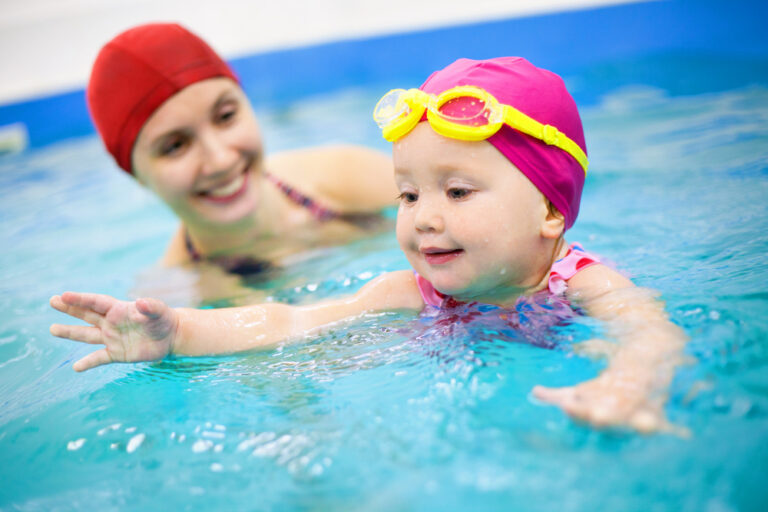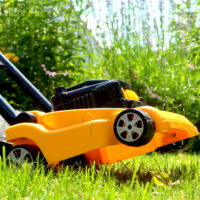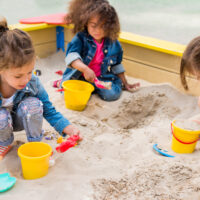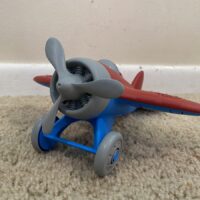If you take the time to teach your baby how to swim, it can literally save their life. An average of ten children under the age of fourteen dies each day from drowning in the United States. This is an extremely startling statistic, that needs to be remedied. What is even more unsettling is that the bathtub is the second most prevalent location that this occurs for children under the age of five. It can all happen in less than a minute. That is why it is so incredibly important to ensure that your baby knows what to do if they are caught underwater.
Start At Home
The American Academy of Pediatrics recommends that parents wait until after their baby’s first birthday to enroll them in swimming classes. Children under the age of one are more likely to inadvertently inhale or swallow water. This can have detrimental health impacts, thus it is best to wait until they reach this milestone.
However, for those families who have risk factors lurking nearby, such as a backyard pool or living by a large body of water, you can technically begin teaching them as early as six months old.
Get Them Comfortable In The Water
Bath time is the best time to start honing your little one’s aptitude for water play! Make a point to not rush through this daily activity. Let them get accustomed to the feeling of being partially submerged. Encourage kicking and splashing. These movements are the building blocks of this essential skill.
Next, when they are soap-free, slowly pour water over their head, having it run down their face. You have to remember that all of these little experiences are brand new to your baby! By taking moments to introduce them to these sensations, you will slowly make them more secure in this liquid environment.
Teach Your Baby How To Float
Once your baby is able to sit up unassisted in the tub, you want to start working on the concept of floating. In the beginning, this is best done with both parents’ assistance. Fill the tub up just far enough so that their little bottom will not touch the base of the tub when lying on their back.
Next, have mom at the head and dad at the feet. Slowly lay them back, while holding them up in the water. Make sure that you are supporting their head, back, and bottom. Do this exercise daily. This activity will acclimate them to the feeling of being suspended in the water! Over time, you can slowly raise the water level, allowing them to hone this skill.
ISR Self-Rescue® Program
This is a fantastic program tailored for kids ages six months to six years old. If you are someone who lives near a body of water, this is a great way to prepare your child for an accidental fall. However, Infant Swimming Resource (ISR) is not your usual swim class. Your baby won’t be learning strokes or swimming laps. Instead, it is all about survival.
In this course, infants will be taught how to roll onto their backs after being submerged in the water. Then they learn to float by themselves. Throughout the training, they learn not to panic, but rather, relax in what would normally be a terrifying scenario.
It is important to remember that if your baby were to fall into the water, they would be weighed down by their clothing, and especially, by their diaper. When you consider the fact that a baby can drown in under sixty seconds, giving them the knowledge of how to handle this type of situation can be the difference between life and death.
That is the goal of this initiative — “Not One More Child Drowns”. According to the founder, they have conducted over eight million of these life-saving lessons in the past fifty years. This has saved over 800 infant lives because they had the proper tools for survival.
Swim Lessons
We have all heard the story of the child who was just thrown into the water only to figure it out on their own. While this tall tale may have worked for some, it is always best to teach a baby to swim through formal instruction.
Why? One example is that if you were to find yourself on a beach vacation, you want your child to know the proper techniques to efficiently move through the water if they were to get sucked into a rip current. These can be extremely dangerous phenomena and you never know where they might be located. Moreover, this is an ability that will last them a lifetime, and riptides do not discriminate based on age.
Beginner Lessons
It is important to remember that before the age of four, your child will likely not be able to swim as the definition implies. Rather, they will learn to float and navigate through the water.
Once they reach the end of their toddler years, they will begin to work on holding their breath, treading water, submerging for short periods of time, and locating an exit if they find themselves struggling. While these things may seem like trivial pursuits, they are a foundation for higher-level swim classes. After they master these abilities, they will start to work on swimming short distances across a pool.
Additionally, these classes involve YOU! This is a spectacular way for you to bond with your child and help them learn essential life skills. Moreover, many of these courses also offer CPR instruction for parents. While you hope to never have to use this technique, having the aptitude to save your child is imperative if an accident were to happen.
Intermediate & Advanced Lessons
In these courses, kids will learn the four main types of strokes — freestyle, backstroke, breaststroke, and butterfly. They will work on endurance as well as rotary breathing techniques. This knowledge will better equip them for long-distance swimming, ocean swimming, and water sports.
Top Qualities To Look For In A Swim Program
When looking for aquatics classes for infants, toddlers, and beyond, it is important to look for a swim instructor who is First Aid and CPR certified. Moreover, these should be individuals who have gone through nationally recognized learn-to-swim programs.
Additionally, for the younger kids, you want a teacher who will always be an arm’s distance away from your baby when they teach them how to swim. This means that they are in the water with them! Finally, in the beginning, smaller classes can allow for more individualized attention. This is key for understanding the various techniques that come with swimming.
Water Safety
Identify Unsuspecting Hazards At Home
As a parent, your job is to always be planning ten steps ahead. While we never want to think about our child in danger, it is important to identify less obvious hazards in our home to help prevent issues from arising.
The obvious places are pools, lakes, and other water sources. However, the bathtub, toilet, water bowls, buckets, fountains, and other seemingly safe amenities can cause a risk to your child’s safety. Always supervise them when in the bathroom and remove potential problem areas from your home.
Think Ahead When Away From Home
Whether your child is going on a playdate with a friend or heading to grandma and grandpa’s for the weekend, it is important to consider if these individuals have a pool or other potential hazards in their homes. Even with a gate, children are very curious and clever creatures. Make sure that these individuals are aware of your child’s ability or inability to swim to better ensure their safety.
FAQs – How To Teach A Baby To Swim
Is it safe to dunk my baby underwater?
Unless you are with a certified swim instructor, it is best to avoid this type of experience. There is a small chance that your child could inhale water and this can be quite detrimental to their health.
What are other attributes that I should look for in a swim class for babies?
The environment is another key feature to look for — a clean, well-maintained pool with temperature controls can allow for safe and comfortable instruction. You want to avoid as many stressors and distractions as possible so that your baby can focus on the task at hand.
Can my baby wear a diaper while in the pool?
Diapers are made to absorb moisture. This is a fantastic attribute for when they go potty, but it can be extremely detrimental for when they are learning how to swim. Instead, invest in a swim diaper. This is created to repel water.
However, if you enroll your baby in an ISR course, once the instructor feels confident in your baby’s floating skills, they will have them practice falling in, fully clothed, to ensure that they could handle an accidental spill into the pool.
Final Thoughts
“If you give a man a fish, you feed him for a day. If you teach a man to fish, you feed him for a lifetime.”
– Lao Tzu
You can babyproof your house and supervise your kids until you are blue in the face. Unfortunately, despite our most valiant efforts, accidents happen. This is why it is always best to give your child the tools to handle any water situation. Furthermore, the earlier that you start, the safer they will be in terms of water safety.
Remember to always establish ground rules for being near water. Consider implementing these rules to better ensure their safety.
- Never get in any water by yourself. This includes the bathtub. An adult needs to be with you and you need to tell them you are getting into the water.
- No running around the pool.
- Always go in feet first to protect your head.
- You have to wear a life vest.
- Never jump in to help someone. Instead, get an adult immediately.
- Never swim in a thunderstorm.
Swimming is a spectacular activity. If you teach your baby how to swim, it promotes physical and mental health, improves sleep, and lowers anxiety. Most importantly, having this skill can save your baby’s life if they find themselves in the right place at the wrong time.






